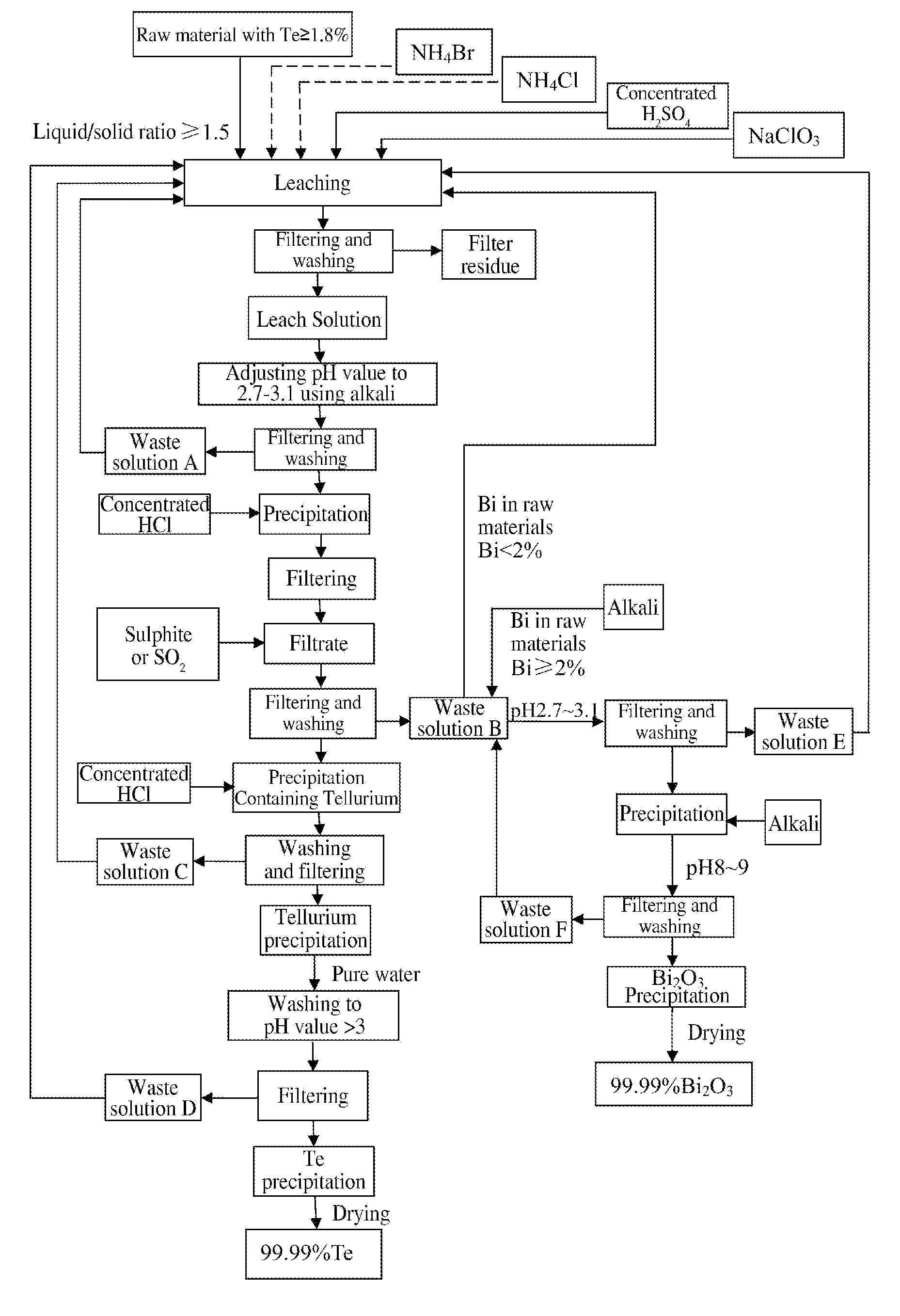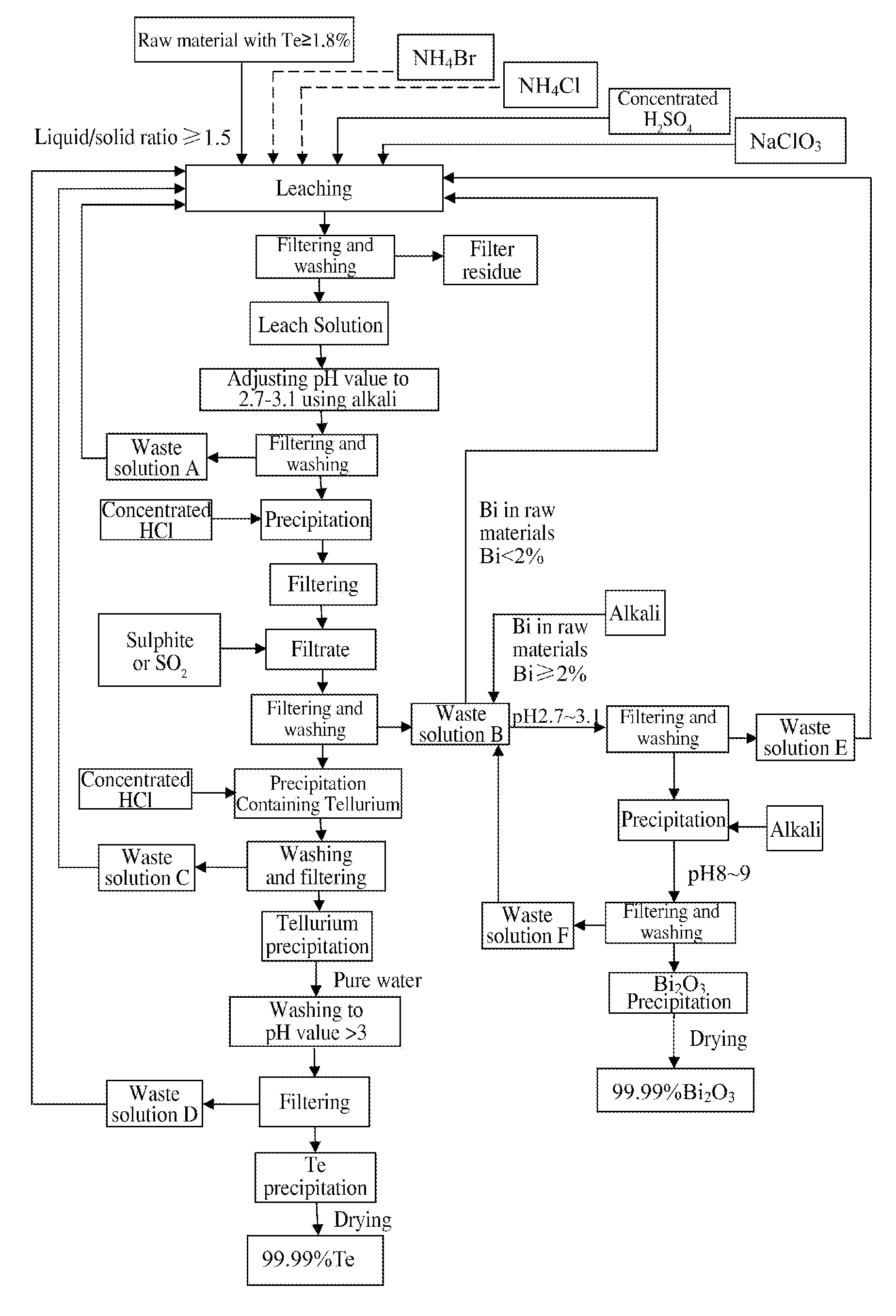Method of extracting Te and bismuth oxide and recovering byproducts
a technology of te and bismuth oxide and byproducts, which is applied in the direction of dissolving, antimony compounds, arsenic compounds, etc., can solve the problems of low recovery rate, high energy consumption, and relatively high production cost, so as to improve the leaching rate and shorten the leaching time , the effect of saving the amount of leaching agents used
- Summary
- Abstract
- Description
- Claims
- Application Information
AI Technical Summary
Benefits of technology
Problems solved by technology
Method used
Image
Examples
example 1
[0029]3 tons of tetradymites are crushed to 80 meshes, and the content of major elements in the raw material is shown in the table below:
[0030]
NameTeBiCuFePbCaSAlSiO2CoNiSecontent %5.89.121.815.50.01917.44.114.087.440.00590.00380.0052
[0031]Liquid-solid ratio is 2, and leaching condition and results are shown in the table below:
[0032]
AmountAmountAmountofofConcentrated H2SO4NaClO3TeBiof liquidNH4ClNH4BrLeachAmountLeachLeachAmountLeachLeachResidualleachleachaddedaddedaddedtimeaddedtimetemp.addedtimetemp.acidityraterate6 m3525 kg60 kg3 h3 T3 h65° C.150 kg5 h95° C.1.5 N98.3%98.6%H2O
[0033]As shown in the above table, during leaching, adding 6m3 of H2O into 3 tons of raw material followed by adding 525 kg NH4Cl and 60 kg NH4Br, leaching for 3 h at ambient temperature; then adding 3 tons of concentrated H2SO4 and leaching for another 3 h with the temperature spontaneously rising to 65° C.; then adding 150 kg NaClO3 and leaching for 5 h under stirring with the temperature spontaneously risin...
example 2
[0038]3 tons of tetradymites are crushed to 100 meshes, and the content of major elements in the raw material is shown in the table below:
[0039]
NameTeBiCuFePbCaSAlSiO2CoNiSecontent %6.619.632.0316.20.017716.83.924.517.540.00540.00450.005
[0040]Liquid-solid ratio is 2, and leaching condition and results are shown in the table below:
[0041]
AmountAmountAmountofofConcentrated H2SO4NaClO3TeBiof liquidNH4ClNH4BrLeachAmountLeachLeachAmountLeachLeachResidualleachleachaddedaddedaddedtimeaddedtimetemp.addedtimetemp.acidityraterate6 m3230 kg48 kg2 h2.9 T2.5 h60° C.150 kg4 h90° C.1.4 N99.1%99.2%wastesolution
[0042]As shown in the above table, adding 6m3 of waste solution separated from Example 1 into 3 tons of raw material followed by adding 230 kg NH4Cl and 48 kg NH4Br, leaching for 2 h at ambient temperature; then adding 2.9 tons of concentrated H2SO4 and leaching for another 2.5 h with the temperature spontaneously rising to 60° C.; then adding 150 kg NaClO3 and leaching for 4h under stirring w...
example 3
[0050]3 tons of tetradymites are crushed to 100 meshes, and the content of major elements in the raw material is shown in the table below:
[0051]
NameTeBiCuFePbCaSAlSiO2CoNiSeContent %6.99.822.315.40.01816.34.324.757.710.0040.00510.0043
[0052]The waste solution separated from example 2 is added at a liquid-solid ratio of 2, and leaching condition and results are shown in the table below:
[0053]
AmountAmountAmountofofofConcentrated H2SO4NaClO3TeBiliquidNH4ClNH4BrLeachAmountLeachLeachAmountLeachLeachResidualleachleachaddedaddedaddedtimeaddedtimetemp.addedtimetemp.acidityraterate6 m3225 kg60 kg2 h2.86 T1 h45° C.150 kg4 h95° C.1.2 N99.7%99.6%wastesolution
[0054]Detailed description for procedures which are the same as Example 2 is omitted herein. Full analysis data of the leach solution and leach residue are shown in the table below:
[0055]
NameTeBiCuFePbCaMgAgAlSiO2CoNiSeLeach solution g / l31.8544.927.125.10.00350.186.030.0316.31.60.0410.450.25Leach residue %0.0230.0210.1115.50.001616.33.50.001...
PUM
| Property | Measurement | Unit |
|---|---|---|
| temperature | aaaaa | aaaaa |
| temperature | aaaaa | aaaaa |
| pH | aaaaa | aaaaa |
Abstract
Description
Claims
Application Information
 Login to View More
Login to View More - R&D
- Intellectual Property
- Life Sciences
- Materials
- Tech Scout
- Unparalleled Data Quality
- Higher Quality Content
- 60% Fewer Hallucinations
Browse by: Latest US Patents, China's latest patents, Technical Efficacy Thesaurus, Application Domain, Technology Topic, Popular Technical Reports.
© 2025 PatSnap. All rights reserved.Legal|Privacy policy|Modern Slavery Act Transparency Statement|Sitemap|About US| Contact US: help@patsnap.com


